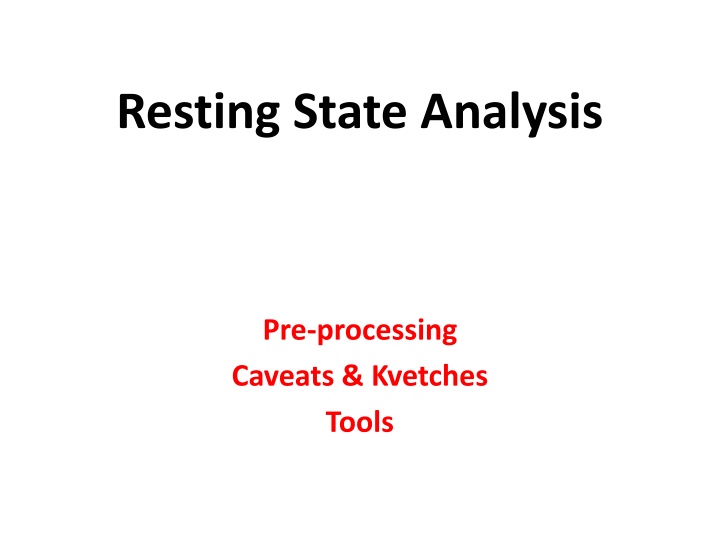
Resting State Analysis in Neuroimaging Studies
An exploration of the challenges and solutions in resting state analysis pre-processing, self-referencing, artifacts, and tools like despiking, motion correction, and more. Learn about dealing with spikes, global signal regression, and the evolving landscape of RS-fMRI data acquisition and processing.
Download Presentation

Please find below an Image/Link to download the presentation.
The content on the website is provided AS IS for your information and personal use only. It may not be sold, licensed, or shared on other websites without obtaining consent from the author. If you encounter any issues during the download, it is possible that the publisher has removed the file from their server.
You are allowed to download the files provided on this website for personal or commercial use, subject to the condition that they are used lawfully. All files are the property of their respective owners.
The content on the website is provided AS IS for your information and personal use only. It may not be sold, licensed, or shared on other websites without obtaining consent from the author.
E N D
Presentation Transcript
Resting State Analysis Pre-processing Caveats & Kvetches Tools
Self-Referencing Basic issue: No external information to tie down the analysis No task timing, no behavior measurements Can only reference data to itself Which means that statistical inference is tricky Artifacts can reduce and/or increase inter- regional correlations of RS data
Issues to Suffer With Spikes in the data Motion artifacts, even after image registration Physiological signals Long-term drifts = low frequency noise Rapid signal changes = high frequency noise BOLD effect is slow, so signal changes faster than time scale of (say) 10 seconds aren t (mostly) BOLD
Solutions via Pre-Processing Despiking the data Slice timing correction Motion correction Spatial normalization, alignment of EPI to anatomy, segmentation of anatomy Extraction of tissue-based regressors of no interest [e.g., ANATICOR (HJ Jo et alii)] Spatial blurring, if any, comes AFTER this step Motion censoring + Nuisance regression [via RetroTS] + Bandpass filtering [all in one step]
Things We Really Dont Like Global Signal Regression (GSR) Its effects on inter-regional correlations are unquantifiable, spatially variable, and can significantly differ between subject groups There is a strong interaction between GSR and subject head motion that is also confusing Poor software implementations of the pre- processing steps and poorly written Methods sections of papers Spatial blurring before tissue-based regressor extraction!
RS-FMRI: Still Condensing from the Primordial Plasma Data acquisition and processing for RS-FMRI is still unsettled MUCH more so than for task-based FMRI How to deal with removal of various artifacts is still a subject for R&D How to interpret the results is also up in the air Convergence of results from different strains of evidence, and/or from different types of analyses is a good thing
Tools in AFNI - 1 afni_proc.py will do the pre-processing steps as we currently recommend Results are ready-to-analyze individual subject time series datasets, hopefully cleaned up, and in standard (atlas/template) space 3dTcorrMap = compute average correlation of every voxel with every other voxel in the brain AKA overall connectedness of each voxel 3dTcorr1D = compute correlation of every voxel time series in a dataset with external time series in a 1D text file
Tools in AFNI - 2 3dAutoTcorrelate = compute and save correlation of every voxel time series with every other voxel time series Output file can be HUMUNGOLIOUS AFNI InstaCorr = interactive tool for testing one dataset with seed-based correlation 3dGroupInCorr = interactive tool for testing 1 or 2 groups of datasets with seed-based correlation
Recent Paper from NIMH Illustrates how to process and think about RS-FMRI data Fractionation of social brain circuits in autism spectrum disorders SJ Gotts, WK Simmons, LA Milbury, GL Wallace, RW Cox, and A Martin Brain Brain 135:2711 135:2711- -2725 (2012) 2725 (2012) doi: 10.1093/brain/aws160
